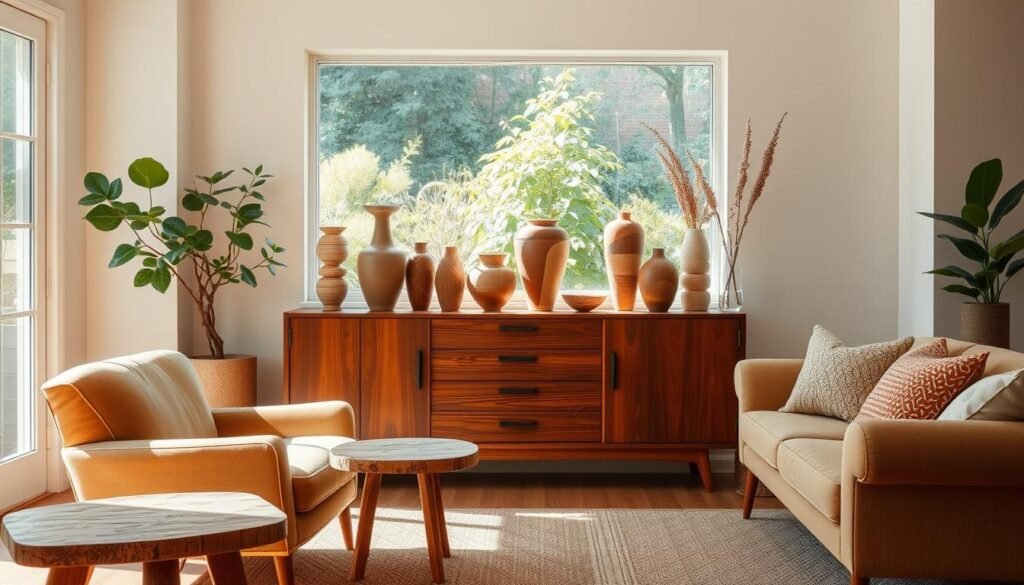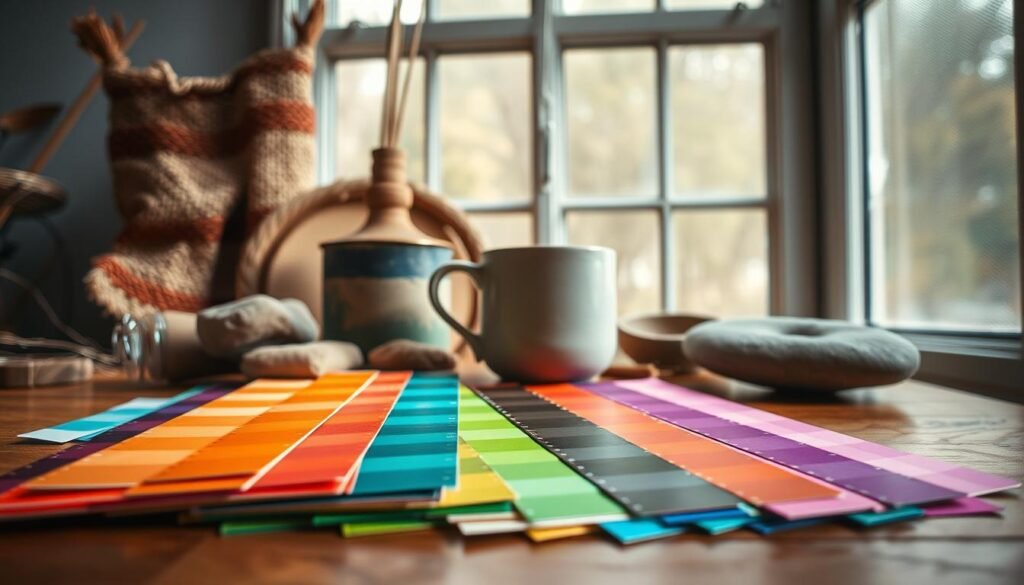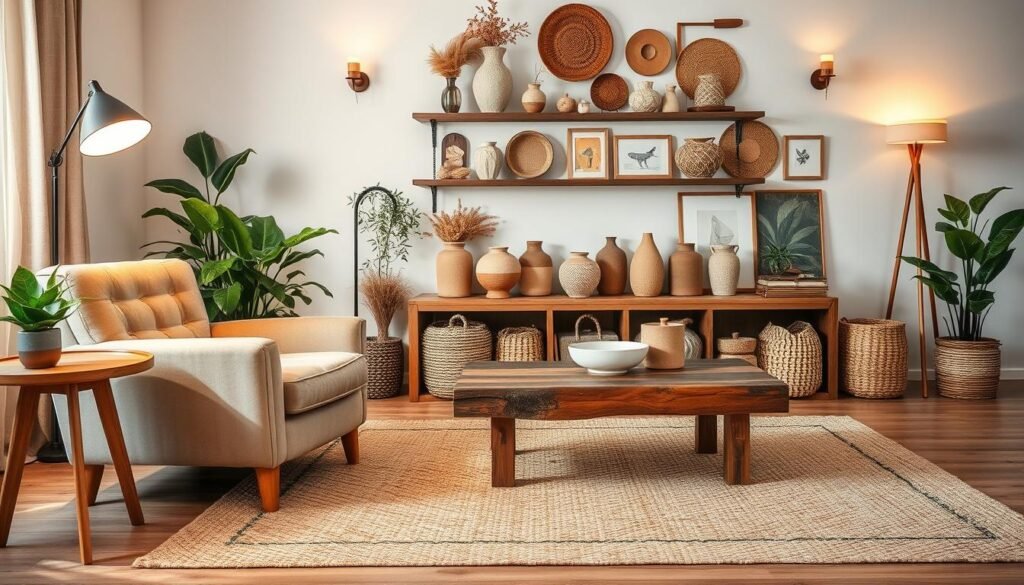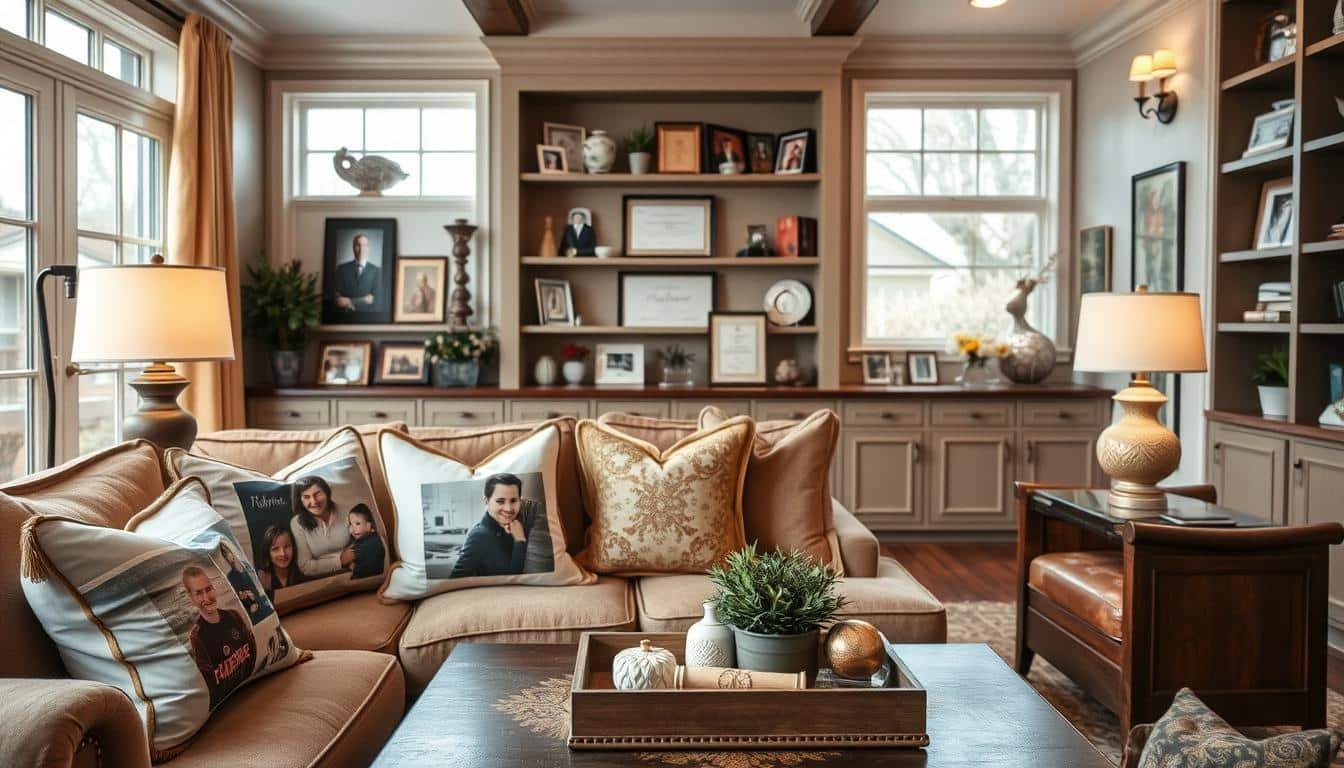This post may contain affiliate links. When you purchase through links on our site, we may earn an affiliate commission.
Walking into a room should feel like stepping into a warm hug, not an art gallery showroom. I used to think stylish interiors required perfect color schemes or trendy furniture. Then I realized: true comfort comes from environments that breathe life into your story.
My living area became my sanctuary when I stopped chasing magazine spreads and started celebrating what makes me uniquely me. That chipped vase from my grandmother’s attic? It now holds wildflowers from my garden. The abstract painting I created during a rainy weekend? It’s the first thing guests notice.
Curating these elements taught me that character comes from intentional choices, not price tags. Every book stack, textile pattern, or weathered photo frame serves as a chapter in my visual autobiography. These details transform four walls into a living scrapbook that evolves with me.
Key Takeaways
- Authentic environments reflect individual stories through curated objects
- Emotional resonance matters more than design trends
- Affordable items gain value through personal significance
- Layered elements create depth and visual interest
- Functional spaces can still showcase personality
- Evolution over time keeps interiors feeling alive
Understanding My Personal Style
Rooms come alive when they whisper your story. My design journey began by decoding visual languages that make my pulse quicken. I keep a digital mood board that’s part scrapbook, part treasure map – guiding me toward choices that feel like home.
Discovering What Inspires Me
Magazine tear-outs cover my desk like confetti after New Year’s. I track patterns in my Pinterest saves: maybe mid-century curves or weathered wood textures. Three questions became my compass:
- Does this color scheme energize or calm me?
- Would I want to touch every surface here?
- Could I imagine this item aging gracefully with me?
Exploring My Design Influences
Great spaces taught me to mix eras like cocktail ingredients. I study how designers layer lighting to create mood theaters. The table below shows how I categorize elements that resonate:
| Style Category | Key Elements | Mood Created | Material Preferences |
|---|---|---|---|
| Modern Organic | Clean lines + natural textures | Grounding | Linen, walnut, terracotta |
| Collected Eclectic | Mixed patterns + global accents | Adventurous | Brass, velvet, hand-carved wood |
| Soft Minimal | Curved shapes + muted tones | Serene | Cotton, bleached oak, matte ceramics |
My guitar now hangs as wall art, its curves echoing my sofa’s silhouette. Nature walks inspire clay vases holding dried botanicals. These connections transform rooms into 3D self-portraits that evolve with each life chapter.
How I Personalize the Space with Meaningful Accessories and Personal Touches
Details are the soul of a room. While furniture sets the stage, it’s the carefully chosen elements that turn blank walls into chapters of your life. My secret? Treat every surface like a scrapbook page waiting for memories.
I hunt for items that do double duty – a hand-painted bowl holding keys becomes a daily reminder of pottery classes with my sister. Vintage lamps cast warm light and stories about their previous owners. Designer Jonathan Adler once said:
“Objects should earn their keep by being useful or beautiful – ideally both.”
Three rules guide my selections:
- Does it spark an immediate emotional reaction?
- Could I explain its origin in one breath?
- Does it complement nearby colors/textures?
Floating shelves display rotating collections – sea glass from Maine summers alternates with miniature succulents in thrifted teacups. My coffee table’s brass tray corrals current reads and a jagged geode that survived three moves. These decor elements become touchstones, grounding me in what matters.
I refresh arrangements quarterly – spring brings ceramic birds nesting beside family photos, while winter features knitted throws from craft fairs. This ritual keeps rooms feeling alive without losing their core identity. The goal? Create spaces that feel like your favorite jeans – broken in, comforting, and unmistakably yours.
Choosing Unique Furniture and One-of-a-Kind Accessories
Conversations start where ordinary meets extraordinary in home decor. I hunt for furniture that stops guests mid-sentence – pieces whispering secrets of previous owners or showcasing artisan craftsmanship. These finds transform rooms into living storybooks.

My rule? If I’ve seen it in five chain stores, it doesn’t belong here. Instead, I seek:
- Dining tables with knife marks from decades of family meals
- Lamps converted from industrial machinery parts
- Textiles featuring regional dye techniques
Supporting Local Designers and Artisans
Saturday mornings often find me at farmers’ markets turned treasure hunts. Last month, I discovered walnut coasters laser-etched with local landmarks. The maker? A retired architect living three miles away.
| Sourcing Venue | Common Finds | Unique Benefits |
|---|---|---|
| Artisan Cooperatives | Hand-blown glassware Custom shelving units |
Meet creators Request custom colors |
| Vintage Collectives | Mid-century armchairs Deco-era mirrors |
Negotiate prices Hear item histories |
| Craft Festivals | Ceramic table lamps Macramé plant hangers |
Limited editions Seasonal materials |
Supporting local talent creates ripple effects. My custom media console came from a woodworker who used reclaimed barn beams. Six months later, three friends commissioned her work. These connections make rooms feel rooted in community while showcasing standout pieces.
Mixing eras keeps spaces dynamic – think 1970s rattan chairs beside AI-designed side tables. The contrast celebrates innovation while honoring craftsmanship traditions. As designer Ilse Crawford notes: “Good interiors aren’t about perfection, but about intelligent contradictions.”
Curating a Color Palette That Reflects My Mood
Walls become mood rings when painted with intention. I treat hues as emotional shorthand – sage green whispers relaxation, while terracotta hums with creative energy. My approach blends science and intuition to craft spaces that feel like wearable emotions.

Mixing Bold and Neutral Tones
Three core shades form my foundation: warm white walls, charcoal trim, and walnut wood tones. These neutrals act as a visual exhale, letting bolder accents shine without competition. I test paint samples at dawn and dusk – morning light transforms peach into neon, while twilight softens navy to near-black.
Accent colors rotate seasonally like a wardrobe. Summer brings cerulean throw pillows echoing lake swims. Winter drapes burnt orange blankets reminiscent of campfire nights. Designer Emily Henderson once noted:
“The best rooms let colors hold conversations across surfaces.”
My current favorite combo? Mushroom-gray walls hosting framed abstract art with pops of persimmon. The secret lies in repetition – that orange reappears in book spines and ceramic vases, creating rhythm without overwhelm. This method turns color into visual music that plays daily.
Mixing Textures and Patterns for a Warm Ambiance
Texture is the secret handshake of great interiors. My rooms gained depth when I stopped matching surfaces and started celebrating friction. Rough meets smooth, matte dances with gloss – these contrasts make eyes linger and hands reach out.

Experimenting with Fabrics and Rugs
I layer materials like a chef seasons dishes – deliberately. A nubby wool throw softens sleek leather chairs, while silk cushions add luxury to a burlap-covered bench. This approach turns furniture into sensory experiences.
| Fabric Combination | Primary Materials | Visual Effect | Color Connection |
|---|---|---|---|
| Velvet + Jute | Cotton, wool | Tactile contrast | Earth tones |
| Silk + Linen | Silk, linen | Luxurious balance | Jewel tones |
| Geometric print + Floral | Mixed textiles | Dynamic harmony | Shared neutrals |
Embracing Bold Prints and Subtle Patterns
Mixing prints became my superpower after learning scale rules. Large-scale jungle leaves on curtains pair with tiny polka-dot cushions. The trick? Anchor them with matching ochre accents in both patterns.
Designer Justina Blakeney says it best:
“Patterns are like spices – the magic happens in bold combinations.”
My current obsession? Layering rugs. A vintage Persian carpet peeks beneath a modern striped runner, creating visual intrigue. These experiments prove rooms feel most alive when textures whisper secrets and patterns tell jokes.
Arranging Personal Mementos and Keepsakes
Memory-filled rooms become mirrors of our lives. I treat every shelf and surface as a stage for life’s milestones. The secret? Letting objects spark conversations about who you are and where you’ve been.
Creating a Heartfelt Gallery Wall
My gallery wall mixes generations like a family reunion. I use mismatched frames in similar metallic finishes to unite childhood snapshots with recent vacation photographs. A pro tip: lay everything on the floor first to test arrangements.
| Display Method | Materials Used | Visual Impact | Rotation Frequency |
|---|---|---|---|
| Floating Shelves | Walnut wood + brass brackets | Modern flexibility | Seasonally |
| Grid Layout | Black metal frames | Structured elegance | Annually |
| Organic Cluster | Mixed materials | Playful energy | Quarterly |
Displaying Travel Souvenirs and Family Photos
I group souvenirs by color rather than origin. A Moroccan tea glass sits beside Maine sea glass, both glowing blue in afternoon light. Family photos get prime real estate – eye-level shelves or console table vignettes.
Rotating pieces keeps displays fresh. Summer brings seashell collections from childhood beaches. Winter showcases ski trip memorabilia in a shadowbox. Designer Nate Berkus once noted:
“The best interiors let you time-travel through objects.”
My current favorite? A vintage map frame marking cities where loved ones live. It’s practical decor that sparks daily connections.
Designing Spaces with Functional and Aesthetic Lighting
Lighting sculpts rooms like invisible hands shaping clay. I discovered its power during late nights reading under a thrifted banker’s lamp – that amber glow turned pages into portals. Now, every fixture serves dual purposes: casting illumination and curating atmosphere.
Selecting Customized Lamps and Fixtures
My hunt focuses on pieces balancing functionality with storytelling. A pendant light with a hand-dyed linen shade becomes floating art by day. Salvaged factory gears transformed into table lamps spark industrial-chic accents. These choices prove lighting can anchor design narratives while serving practical needs.
String lights draped across my bookshelves hold Polaroids from road trips. Smart bulbs shift hues – golden dawn tones for morning coffee, deep blues for movie nights. This blend of tech and tradition lets rooms adapt like living organisms.
By treating each light source as a brushstroke, I paint spaces that shift moods with a tap. The result? Environments radiating warmth while reflecting life’s ever-changing rhythm.

 using WordPress and
using WordPress and 
No responses yet